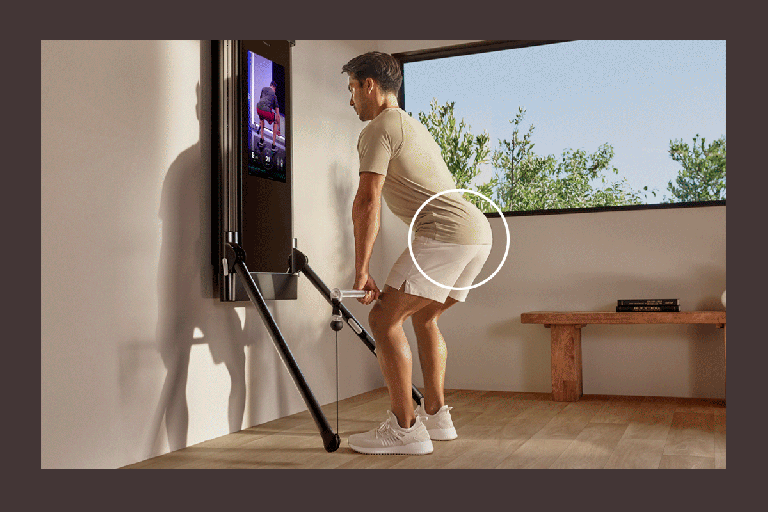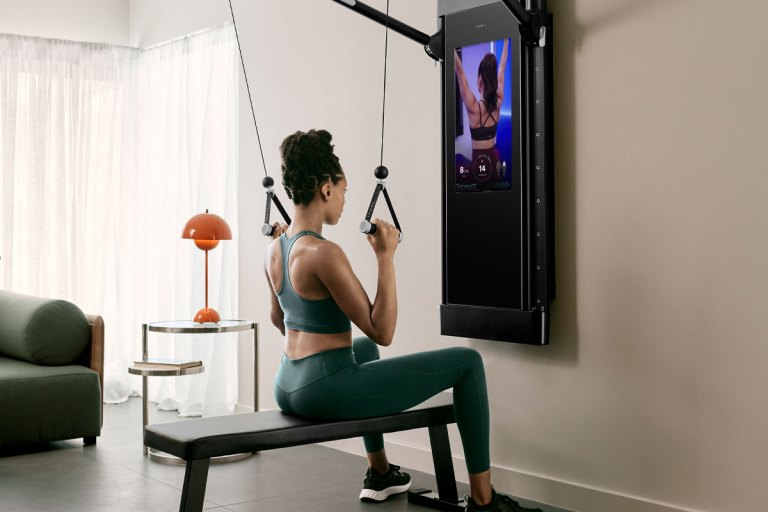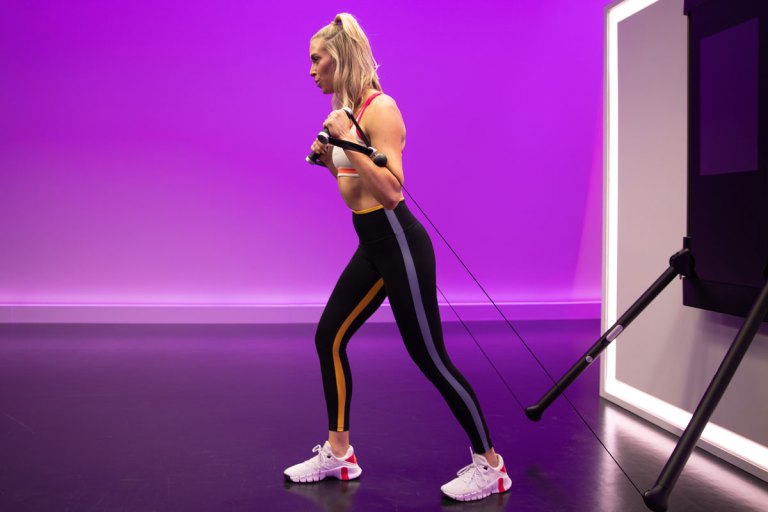Save Time and See Results Faster with This Leg and Shoulder Workout
Here’s how supersets can help you get more work done in one session.

There are multiple ways to structure your training that all deliver results, including body-part splits and push-pull workouts. The exact strategy you choose depends on your specific goals and what fits into your schedule. Training non-competing muscle groups–such as in a chest and back or leg and shoulder workout–is a highly-efficient method to attack two body parts in the same workout, increasing your work capacity while allowing each muscle group time to recover.
Can I Work My Legs and Shoulders Together?
According to Jenna Moore, a certified strength and conditioning coach and Programming Specialist at Tonal, training your legs and shoulders together in one workout is a solid option if you’re seeking a time-efficient session that works your upper and lower body.
To make the most out of this type of workout, Moore recommends including supersets, in which you perform two exercises back to back. “While you’re working your legs, your shoulders are recovering [and vice versa],” she says. “You’re able to move through the workout a little quicker, your muscles are able to recover, and you don’t spend as much downtime sitting around and resting.”
As a caveat, Moore explains that these workouts are most effective if your goals are hypertrophy or endurance instead of maximum strength gains. “When you’re working for strength and doing those lower rep ranges, you’re going to need more rest than the 60 seconds you spend doing a shoulder [or leg] exercise,” she says.
Moore says a leg and shoulder workout featuring supersets is especially effective for muscle size gains, though, because it allows you to accumulate high volume and time under tension, two of the primary drivers of hypertrophy. Similarly, by doing higher reps with short rest periods and not allowing full recovery in between, she says you can see a big boost in muscular endurance and work capacity.
Leg and Shoulder Workout with Supersets
For a well-rounded workout that challenges your legs and shoulders, Moore recommends the following three-block session. Each block includes a superset consisting of one leg and one shoulder exercise meant to be done with minimal rest in between. You can do this workout once or twice each week, and target other major muscle groups such as your back, chest, and arms on alternate days.
This workout can easily be modified or scaled for your specific aims. “If you’re going for hypertrophy, anywhere in that 6-12 rep range is great,” says Moore, “and if you’re looking for stamina and endurance, 12-plus would be that rep range. She suggests doing two to three sets of each block, so you can start with two and progress to three as you get more experienced.
If you’re short on time or want a leg and shoulder workout for beginners, only do one or two sets of 8-12 reps of each exercise. “If that’s all the time you have while you’re heating up dinner or something, then just get it done,” says Moore. “That’s better than doing nothing.”
Block 1
Goblet Squat

Why it Works: “When we’re talking about lower body, we’re always thinking about getting in a squat, a hinge, and a lunge,” says Moore. Including these three basic movement patterns in your session ensures you’re hitting your glutes, hamstrings, and quads equally. Kick-off this workout with a basic goblet squat.
How to Do it: Hold the handle strap with your thumbs wrapped around the top and position it in front of your chest. Stand with feet shoulder-width apart and toes slightly turned out. Reach your hips down and back like you’re sitting into a chair behind you. Push the floor away from you and stand tall powering the hips toward Tonal and repeat.
Standing Overhead Press

Why it Works: You’ll alternate the goblet squat with a standing overhead press, an essential move for strengthening the shoulders. The standing variation requires a strong core to maintain an upright posture, but if that feels too challenging, try doing this move in a seated position instead.
How to Do it: Press both arms up overhead reaching the knuckles toward the ceiling, but keeping the shoulders pulled toward the floor. Bend the elbows to slowly bring the hands back to start.
Block 2
Alternating Goblet Reverse Lunge

Why it Works: As a unilateral exercise, the reverse lunge tests your single-leg strength and builds balance and stability.
How to Do it: Hold the handle at the strap with thumbs wrapped around the top and place it in front of the chest. Stand tall at the end of Tonal’s arm. Reach one leg back, keeping the other foot planted on the floor, and lower down until both knees are bent 90 degrees and the back knee is just above the floor. Press the floor away from you, using the glute of the front leg to power back up to start and switch sides.
Lateral Raise
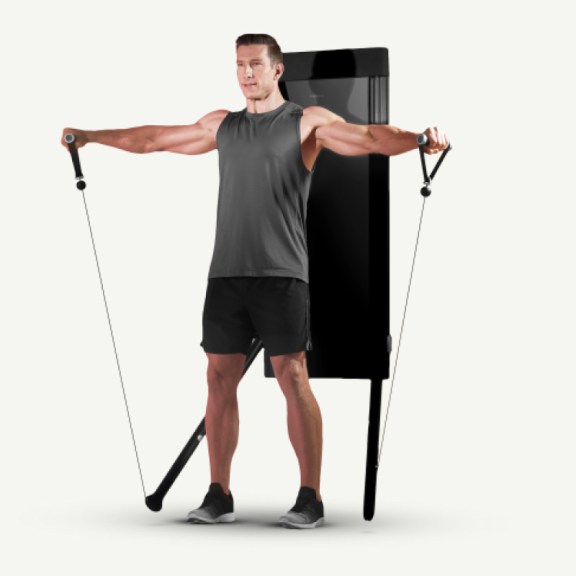
Why it Works: For overall shoulder health, Moore explains that you need to work the joint from different angles, not just through overhead pressing. “Your shoulder joint is one of the more mobile joints of your body,” she says. “It can do flexion, extension, abduction, and rotation. There are so many different ways to work the shoulders.” The lateral raise works your middle deltoids as well as your back muscles.
How to Do it: Take a handle in each hand and stand facing away from Tonal. With soft elbows, lift your arms up to your sides toward the ceiling until they reach shoulder height. Lower the arms with control and repeat.
Block 3
RDL

Why it Works: This final lower-body move, the Romanian deadlift, covers the hinge pattern and emphasizes hamstring development.
How to Do it: With feet hip-width apart, toes lined up with the end of Tonal’s arms, take a handle in each hand and stand tall. With palms facing behind you, slide your hands down your thighs as you reach your hips back like someone is pulling you from behind. Squeeze your glutes and power your hip forward to come back up to standing, sliding the handles up the legs.
Standing Face Pull
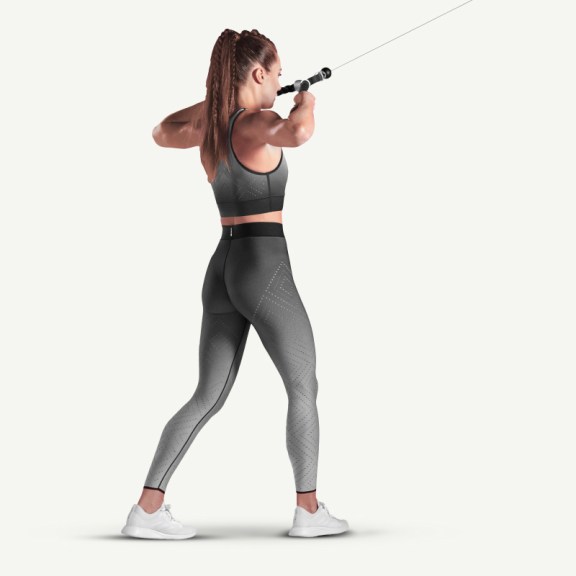
Why it Works: You’ll round out your shoulder work with this move which, as Moore explains, targets the rear deltoids and posterior side of the shoulder joint.
How to Do it: Using the shoulders and back, pull the rope toward your ears by aiming your elbows wide at the wall behind you. Slowly move your hands forward to finish.
